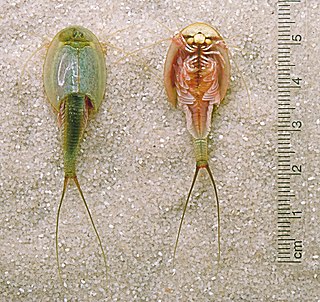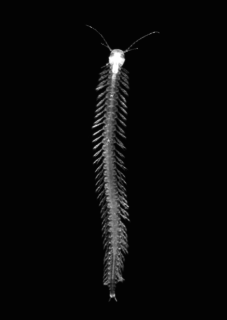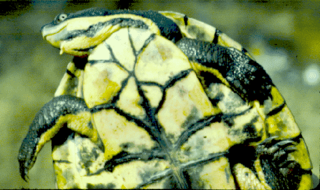| Alona | |
|---|---|
| Scientific classification | |
| Kingdom: | |
| Phylum: | |
| Subphylum: | |
| Class: | |
| Order: | |
| Family: | |
| Genus: | Alona W. Baird, 1843 |
| Type species | |
| Alona quadrangularis (O. F. Müller, 1776) | |
Alona is a genus of cladocerans in the family Chydoridae. It is one of the largest genera of Cladocera, [1] and is widely believed to be an artificial group which is in need of systematic revision; the type species is Alona quadrangularis . [2] Around 240 names at the species level have been described in Alona; it is unclear how many of these are valid, or how they are related. [3]
Species currently assigned to the genus Alona include:

Branchiopoda is a class of crustaceans. It comprises fairy shrimp, clam shrimp, Cladocera, Notostraca and the Devonian Lepidocaris. They are mostly small, freshwater animals that feed on plankton and detritus.

Daphnia is a genus of small planktonic crustaceans, 0.2–6.0 mm (0.01–0.24 in) in length. Daphnia are members of the order Cladocera, and are one of the several small aquatic crustaceans commonly called water fleas because their saltatory swimming style resembles the movements of fleas. Daphnia spp. live in various aquatic environments ranging from acidic swamps to freshwater lakes and ponds.

Remipedia is a class of blind crustaceans found in coastal aquifers which contain saline groundwater, with populations identified in almost every ocean basin so far explored, including in Australia, the Caribbean Sea, and the Atlantic Ocean. The first described remipede was the fossil Tesnusocaris goldichi. Since 1979, at least seventeen living species have been identified in subtropical regions around the world.

Clam shrimp are a taxon of bivalved branchiopod crustaceans that resemble the unrelated bivalved molluscs. They are extant, and known from the fossil record, from at least the Devonian period and perhaps before. They were originally classified in a single order Conchostraca, which later proved to be paraphyletic, being separated into three different orders: Cyclestherida, Laevicaudata, and Spinicaudata, but excluding the fairy shrimp (Cladocera), which are most closely related to the Cyclestherida.

Onychopoda are a specialised order of branchiopod crustaceans, belonging to the superorder Cladocera.

Streptocephalus is a genus of fairy shrimp found in temporary waters in Africa, Australia, Eurasia, and Central and North America, following its ancient origin in Gondwana. It contains the following species:

Pseudothelphusidae is a family of freshwater crabs found chiefly in mountain streams in the Neotropics. They are believed to have originated in the Greater Antilles and then crossed to Central America via a Pliocene land bridge.

The Cladocera, commonly known as water fleas are an order of small crustaceans that feed on microscopic chunks of organic matter.

Daphniidae is a family of water fleas in the suborder Anomopoda.
Gondwanothrix halsei is a species of small crustaceans within the order Cladocera, in the suborder Anomopoda, placed in its own family, Gondwanotrichidae. It exists in a macrotrichid habitus found in humic coastal dune lakes and swamps in southwest Western Australia. The species' type locality is Angove Lake in the Two Peoples Bay Nature Reserve.

The Myuchelys is a genus of turtles, the Australian saw-shelled turtles, in the family Chelidae and subfamily Chelodininae. They inhabit the headwaters and tributaries of rivers within their range and this led to the name Myuchelys, which is formed from the Aboriginal word myuna meaning clear water and the Greek chelys meaning turtle. They have a short neck and the intergular scute completely separates the gular scutes. They have no alveolar ridge separating them from the snapping turtles of the genus Elseya.

Leptodora is a genus containing two species of large, nearly transparent predatory water fleas. They grow up to 21 mm (0.83 in) long, with two large antennae used for swimming and a single compound eye. The legs are used to catch copepods that it comes into contact with by chance. Leptodora kindtii is found in temperate lakes across the Northern Hemisphere and is probably the only cladoceran ever described in a newspaper; L. richardi is only known from eastern Russia. For most of the year, Leptodora reproduces parthenogenetically, with males only appearing late in the season, to produce winter eggs which hatch the following spring. Leptodora is the only genus in its family, the Leptodoridae, and suborder, Haplopoda.
Celsinotum candango is a species of crustaceans. Its epithet comes from the name applied to people that built the city of Brasilia and was subsequently used for its inhabitants. The species was found in Lagoa do Henrique, a freshwater pond in the Brasília National Park. Its body is high and rounded, with a low dorsal keel. Its last 5–8 ventral setae ventral setae thick and spiniform, carrying 1–3 setules on their posterior margin. Its head shield and head pores are the same as its cogenerate species, as is its labrum, antenna and antennule and thoracic limbs. Celsinotum candango other species of the genus in the proportions of its postabdomen, given the postanal portion is 1.2–1.3 times longer than the anal one in all other species. It differs from Australian species by its less developed keel, the lateral head pores which are located close to midline, a longer spine on the basal segment of the antenna exopodite, and by the presence of very big projections on the latter. The Brazilian C. Laticaudatum differs from C. candango by having a longer spine on the basal segment of the antenna exopodite, in the shape of its postabdomen, and in postabdominal denticles, which in this species are long and single.

Daphnia longispina is a planktonic crustacean of the family Daphniidae, a cladoceran freshwater water flea. It is native to Eurasia. D. longispina is similar in size and sometimes confused with the often sympatric D. pulex, but much smaller than D. magna. D. longispina is found in a wide range of standing freshwater bodies from small, ephemeral rock-pools to large lakes.
Macrothricidae is a family of anomopods in the order Diplostraca. There are about 17 genera and at least 80 described species in Macrothricidae.
Cactus is a genus of anomopods in the family Macrothricidae. There is only one described species, Cactus cactus. C. cactus can be found in Chile.
Bosmina freyi is a species of anomopod in the family Bosminidae.
Chydoridae is a family of water fleas in the order Anomopoda. There are more than 50 genera and 520 described species in Chydoridae.
Iphigenellidae is a freshwater family of amphipods in the superfamily Gammaroidea. It is found in the Ponto-Caspian region, which encompasses the Black, Azov, and Caspian Seas.

Eurycercus is a genus of crustaceans belonging to the suborder Anomopoda. It is the only genus in the monotypic family Eurycercidae. Eurycercus are relatively large anomopods, reaching sizes as large as 6 mm (0.2 in).